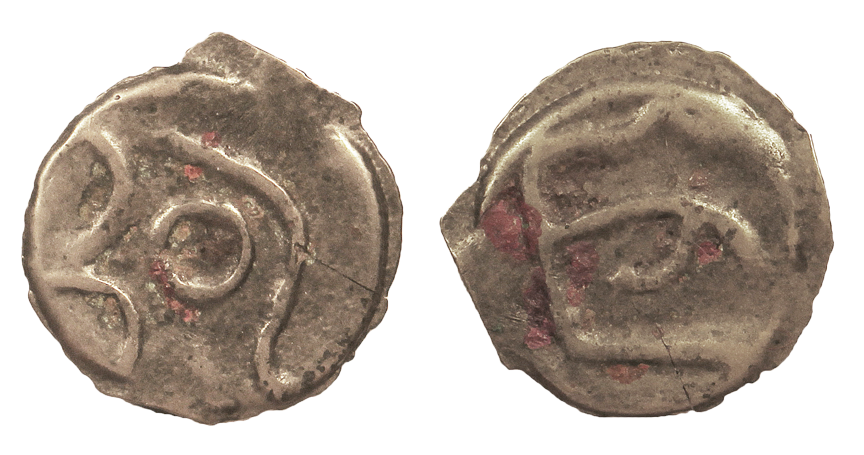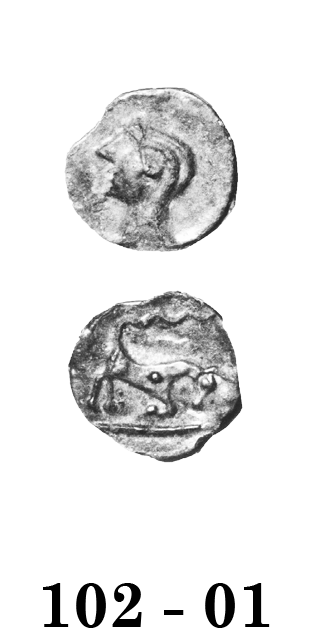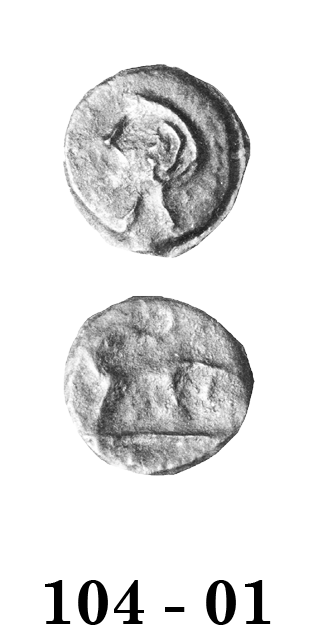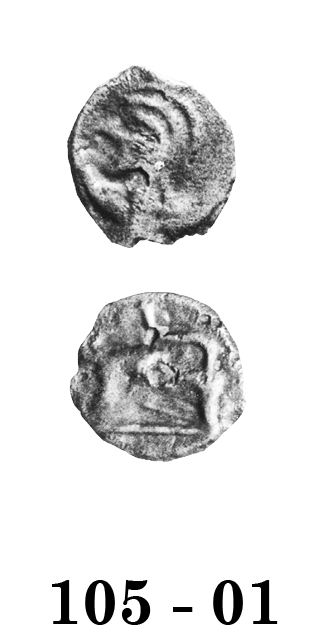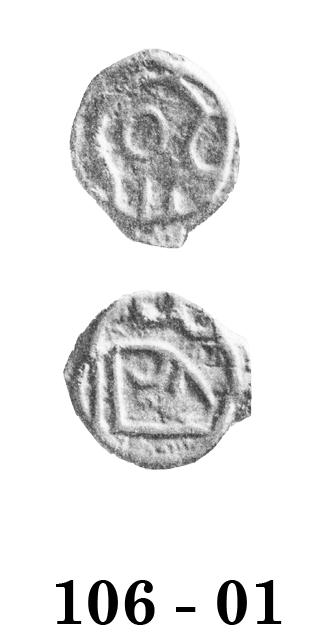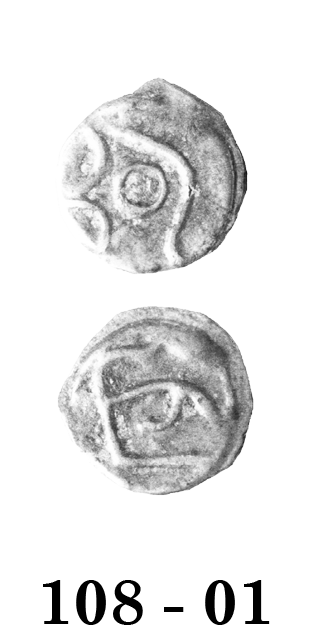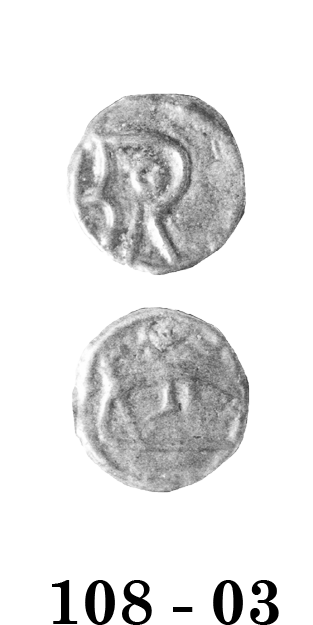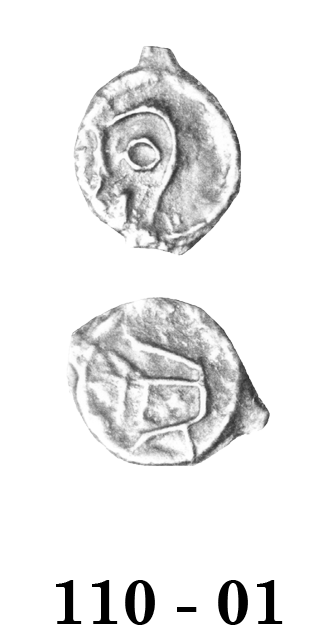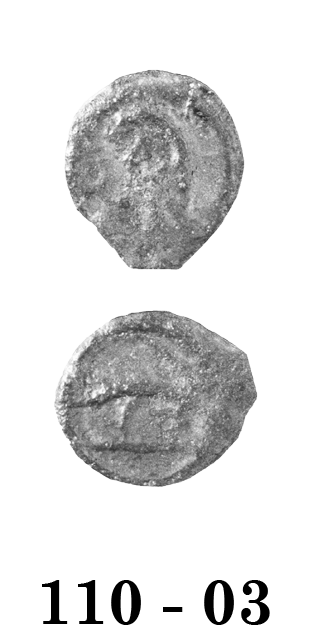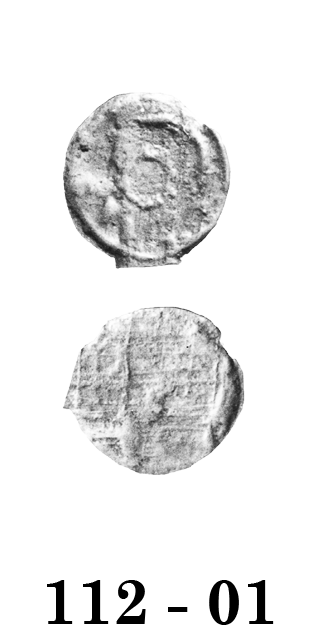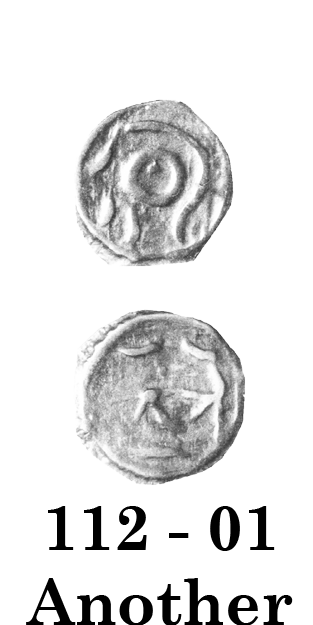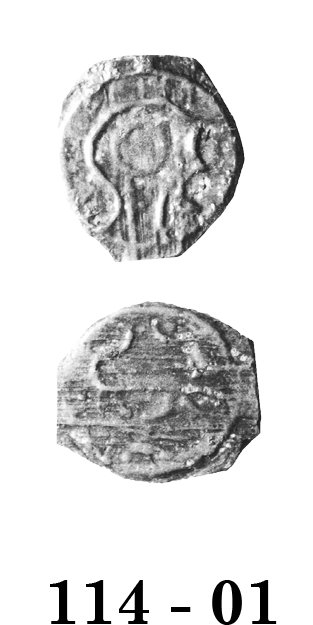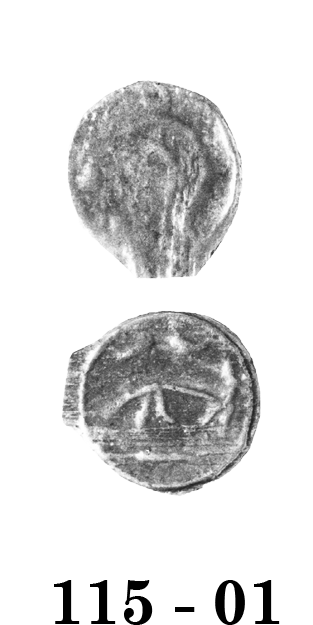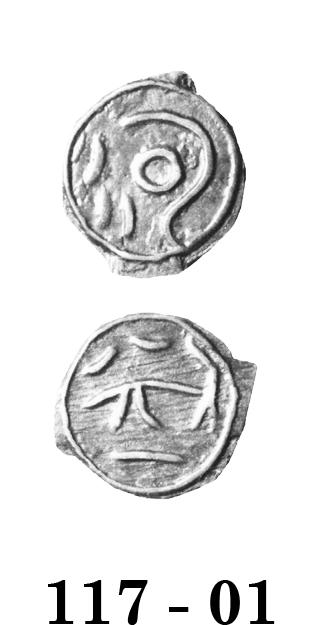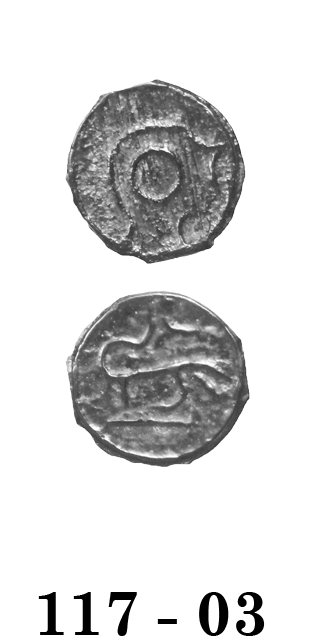
Celtic Coinage of Britain
third edition
Click on coin to see hidden information
The Cast Bronzes of Kent
The Cast Bronzes were produced for sixty-five years, and most of the time the aesthetic qualities were carefully controlled. In general, cast coins tend to become thick and dumpy in appearance and this posed a problem. The Kentish tribes wanted their coins to be more anesthetically pleasing. Casting large, thin coins posed many technical problems and so the success the moneyers achieved is a tribute to their metal-working expertise. All the coins were cast in chains using clay moulds with a runner system connecting the cavities. The methods used to manufacture' the moulds changed over time as the workers perfected their techniques.
For most of the series, the images were scribed freehand into the clay moulds. Traditionally, these images have been used to establish a type sequence widely used in archaeological work. Today however, the coins are seen to be mass-produced items. The stylus work was done as quickly as possible and thus the images provide little basis for establishing the sequence.
A better indicator of types are the marks produced by the different mould manufacturing processes. These yield a plausible chronological sequence, consequently, the following catalogue is primarily concerned with the mould manufacturing techniques. The images are taken into account only when major differences in artistic style are noted. For example, at some point the images on the reverse switch from curvilinear forms to boxy ones. The change may indicate the appearance of a new moneyer or a modification to the coining techniques.
The first three periods of manufacture occurred quickly and in rapid succession, as the moneyers sought the best production methods. After the techniques were perfected, an enormous number of coins were produced over a long period. Quantities of hundreds of thousands (perhaps millions) are thought to have been cast and several thousand examples exist today.
Prototype Period ca. 100 B.C.
These were the first coins manufactured in Britain, the images were adapted directly from the cast bronzes of Masillia. At first, the images were produced using mother-coins. This technique was immediately changed to speed up production—the image was then scribed into the mould with a stylus. The coins of the Prototype Period were thick and dumpy, and evidently unacceptable to the Kentish tribes.
Experimental Period ca. 100 B.C.
The mould production method was again changed—a smooth dowel was now pressed into the wet clay to produce the cavity. The sprues and the image were then scribed in with a blunt stylus. Manufacturing problems in the Experimental Period were severe. The moulds did not mate very well, allowing metal to squeeze out and produce 'flash'. Misalignment of the moulds during casting produced an offset between the obverses and reverses. Furthermore, the coins still had a thick, dumpy feel because they were thinner only at the edges.
Innovative Period ca. 100 B.C to 90 B.C
The moneyers worked to eliminate the problems during the Innovative Period. Various techniques of producing the cavity-and-runner system were tried and experiments to create smooth mating-surfaces were carried out—all producing striations in the coins' fields. Four types of striations have been identified: CROSSED, MEDIUM, HEAVY and THIN, each revealing a different technique of mould production.
The Crossed Striations were produced by textile pressed into the clay to form the cavity and runner system. Medium Striations were the result of cutting a block of clay in two with a wire in an attempt to produce perfectly-mating moulds. Heavy Striations were produced by pressing the clay against a wooden surface to smooth it. None of these techniques was particularly successful— either excessive flash resulted or the striations were so severe the stylus image was ruined.
The Thin Striation coins are the commonest, because the technique was more successful and was employed for a longer time. These were produced by smoothing the clay with a flat scraper.
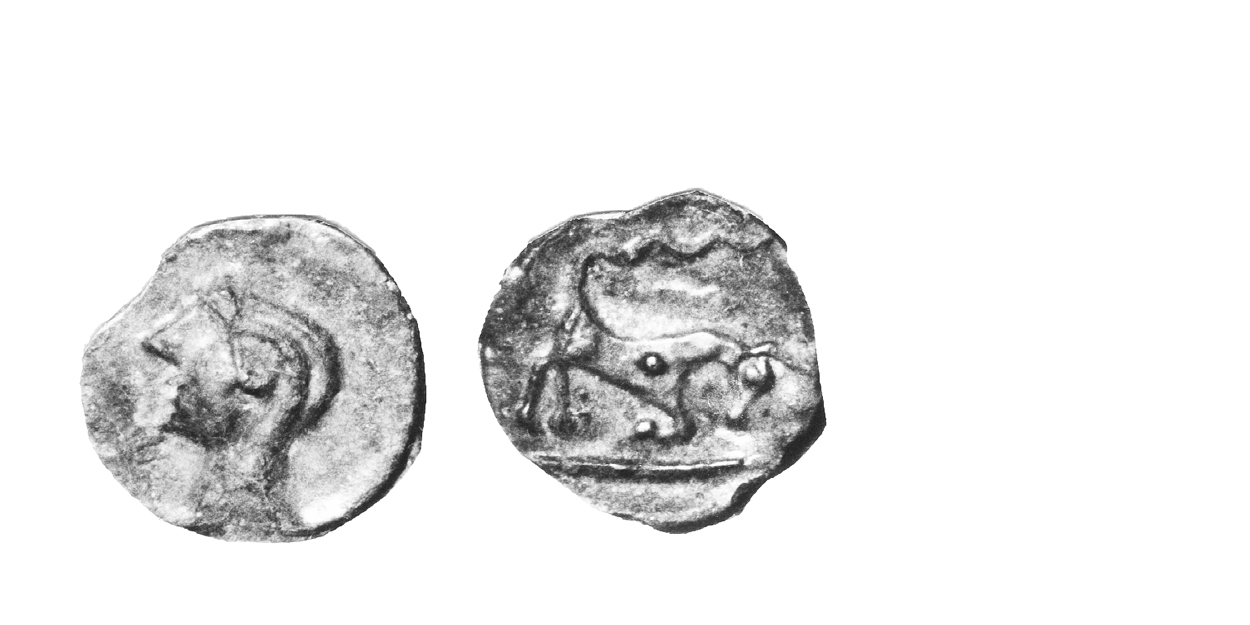
102 - 01 Life-Like Bull Type
ca. 100 B.C. Extremely Rare
Cast Bronze ca. 2.2 gms. 18 mm
Earliest Record: Van Arsdell, 1986b
OBV: Celticized head of Apollo left
Identifying points:
1) head relatively naturalistic
REV: Celticized bull charging right
Identifying points:
1) relatively life like bull charging right
2) pellet on body of bull
CLASSIFICATION: Cantian A
NOTES:
- This is the earliest extant coin manufactured in Britain
- The parting line around the edge and the sprues (casting tabs) indicate a casting process was used.
- A mother-coin was used to produce the image in the mould
- This type was copied directly from the cast coinage of Masillia
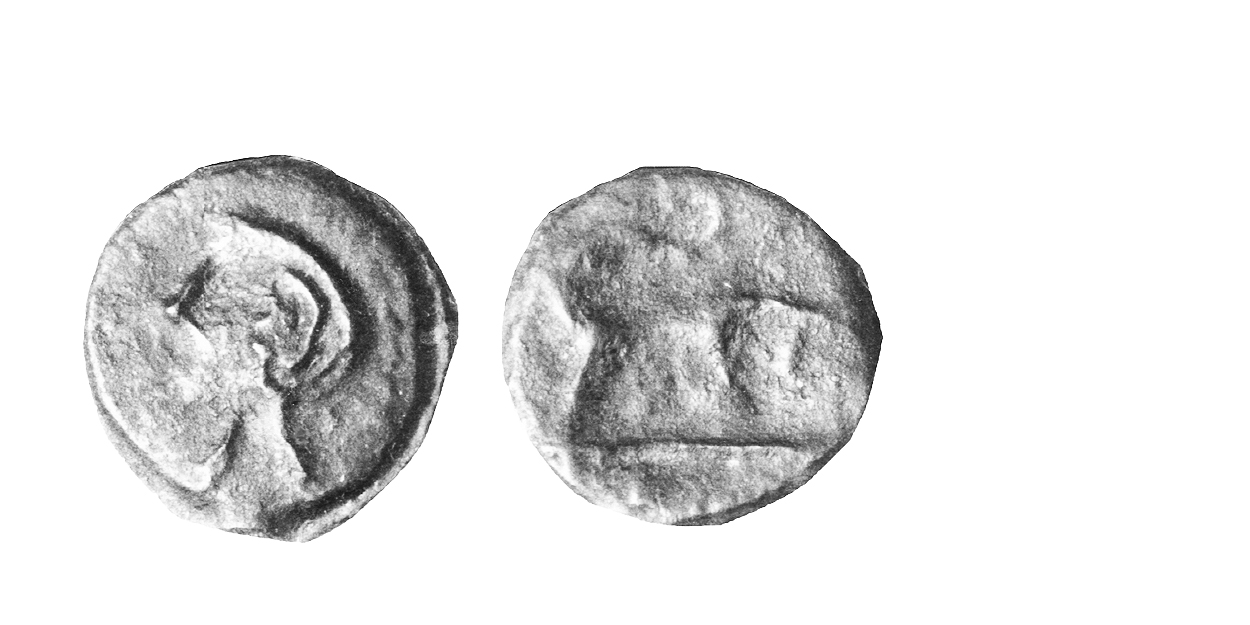
104 - 01 Abstract Bull Type
ca. 100 B.C. Very Rare
Cast Bronze ca. 2.6 gms. 20 mm
Earliest Mention: Van Arsdell, 18986b
OBV: Celticized head of Apollo left
Identifying points:
1) head now scribed-in with a stylus, but an attempt made to produce a life-like image
REV: Celticized bull charging right
Identifying points:
1) same stylus technique used
CLASSIFICATION: Cantian A
NOTES:
- Celtic Coin Index records now indicate commoner than previously thought
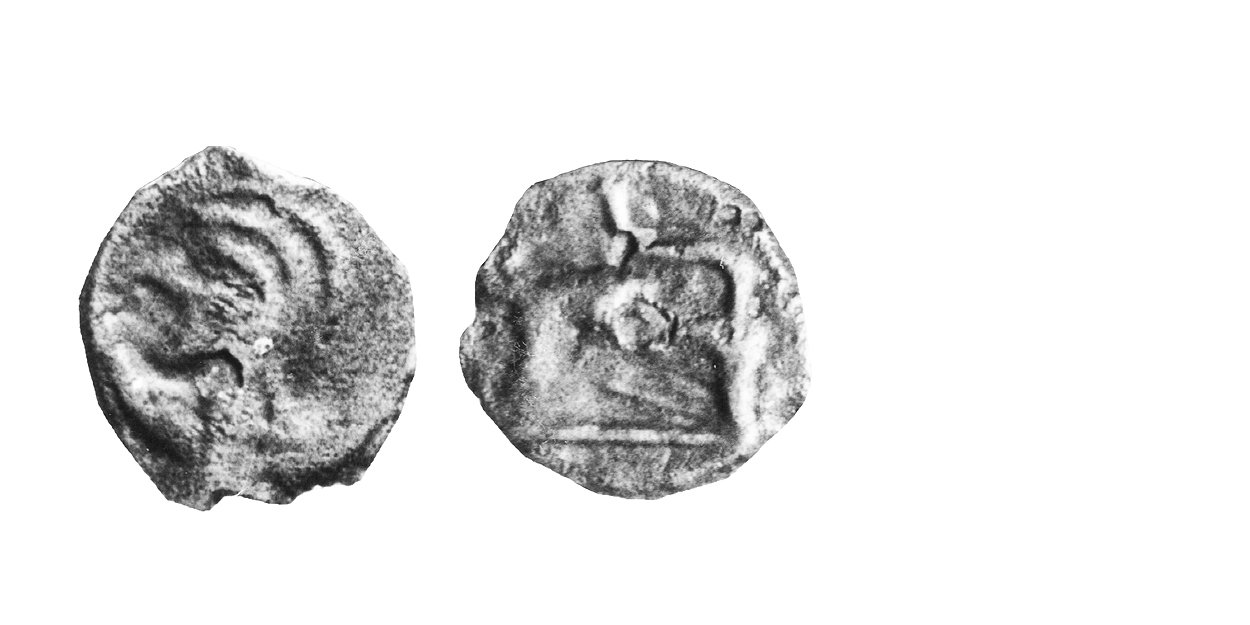
105 - 01 Abstract Bull Type
ca. 100 B.C Very Rare
Cast Bronze 18 mm
Earliest Record: Mack, 1964
OBV: Celticized head of Apollo left
Identifying points:
1) head now scribed-in with a stylus, but an attempt made to produce a life-like image
REV: Celticized bull charging left
Identifying points:
1) same stylus technique used
2) as 104-1, but bull faces opposite direction
CLASSIFICATION: Cantian A
NOTES:
- Celtic Coin Index records now indicate commoner than previously thought
- This type was directly derived from 102-1
- This type is often confused with the Thurrock Type
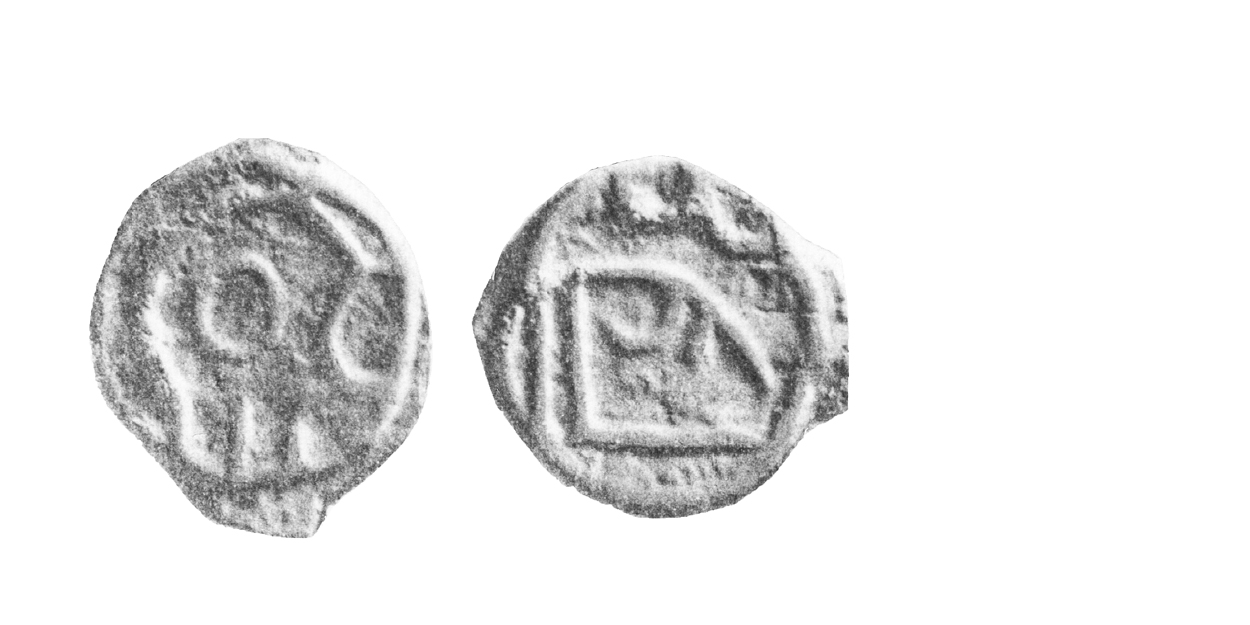
106 - 01 Curved Bull Type
ca. 100 B.C. Extremely Rare
Cast Bronze 18 mm
Earliest mention: Mack, 1953
OBV: Celticized head of Apollo right
Identifying points:
1) head now comprised of lines, no attempt at life like reproduction
REV: Celticized bull charging right
Identifying points:
1) same linear style as obverse
2) lines of bull are curved
CLASSIFICATION: Cantian B
NOTES:
- The coin is thicker at the edges than at the centre because of the scribed edge-circle
- Occasionally a coin will have an obverse cavity of a different diameter than the reverse. The upper surface of the mould is then imaged at the edge of the coin on the smaller diameter side. This is smooth, indicating a scraping motion was not used to produce the mating surfaces.
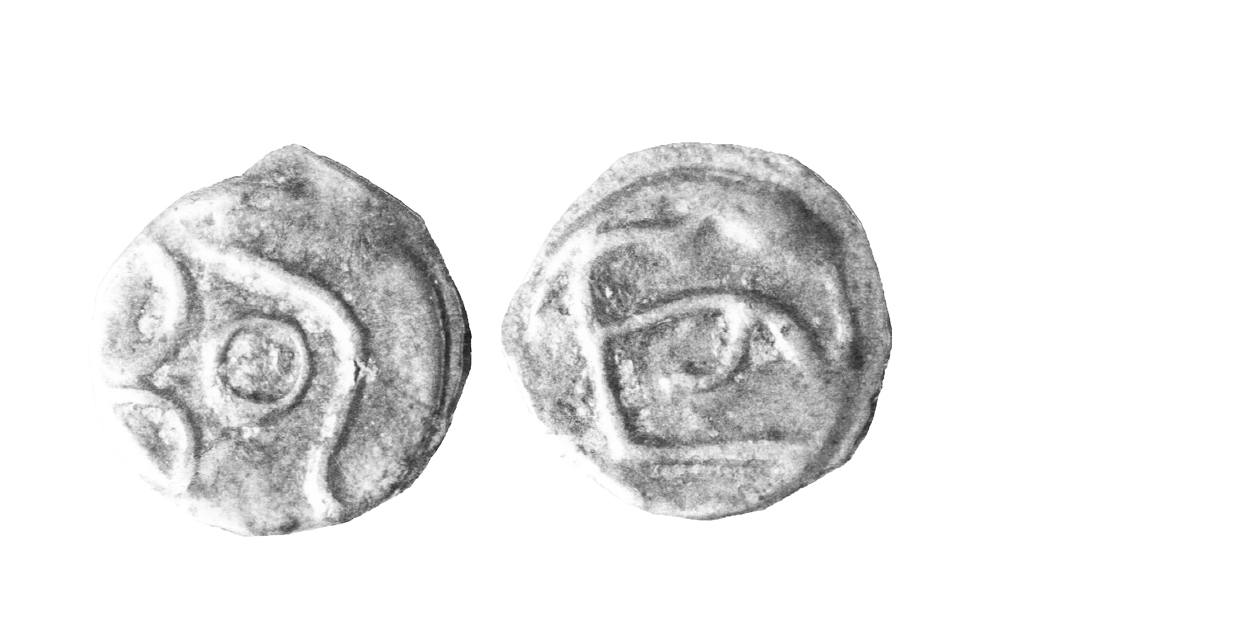
108 - 01 Curved Bull Type
ca. 100 B.C. Very Rare
Cast Bronze ca. 1.7 gms. 19 mm
Earliest Record: Mack, 1953
OBV: Celticized head of Apollo left
Identifying points:
1) head now comprised of lines, no attempt at life like reproduction
1) as 106-1, but head faces left
REV: Celticized bull charging right
Identifying points:
1) same linear style as obverse
2) lines of the bull are curved
CLASSIFICATION : Cantian B
NOTES:
- Celtic Coin Index records now indicate commoner than previously thought
- The coin is thicker at the edges than at the centre because of the scribed edge-circle
- Occasionally a coin will have an obverse cavity of a different diameter than the reverse. The upper surface of the mould is then imaged at the edge of the coin on the smaller diameter side. This is smooth, indicating a scraping motion was not used to produce the mating surfaces.
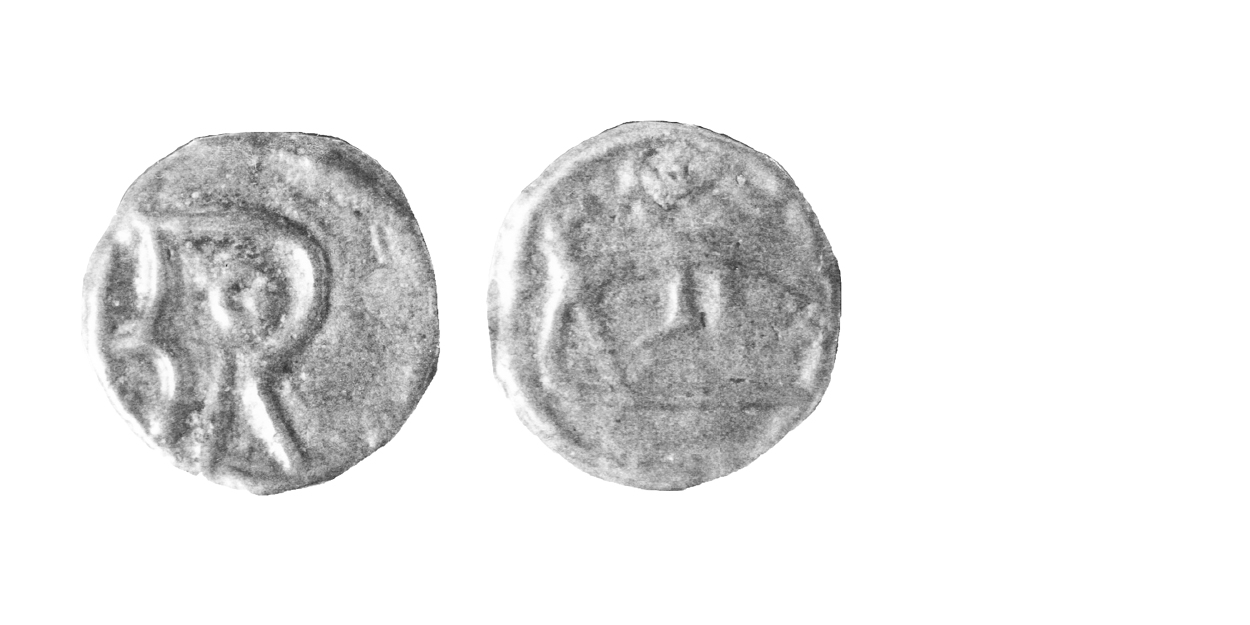
108 - 03 Curved Bull Type
ca. 100 B.C. Scarce
Cast Bronze ca. 1.7 gms. 19 mm
Earliest Record: Allen, 1971
OBV: Celticized head of Apollo left
Identifying points:
1) head now comprised of lines, no attempt at life like reproduction
2) as 106-1, but head faces left
3) line runs vertically through neck
REV: Celticized bull charging right
Identifying points:
1) as 106-1
CLASSlFlCATION: Cantian B
NOTES:
- Celtic Coin Index records now indicate commoner than previously thought
- The coin is thicker at the edges than at the centre because of the scribed edge-circle
- Occasionally a coin will have an obverse cavity of a different diameter than the reverse. The upper surface of the mould is then imaged at the edge of the coin on the smaller diameter side. This is smooth, indicating a scraping motion was not used to produce the mating surfaces.
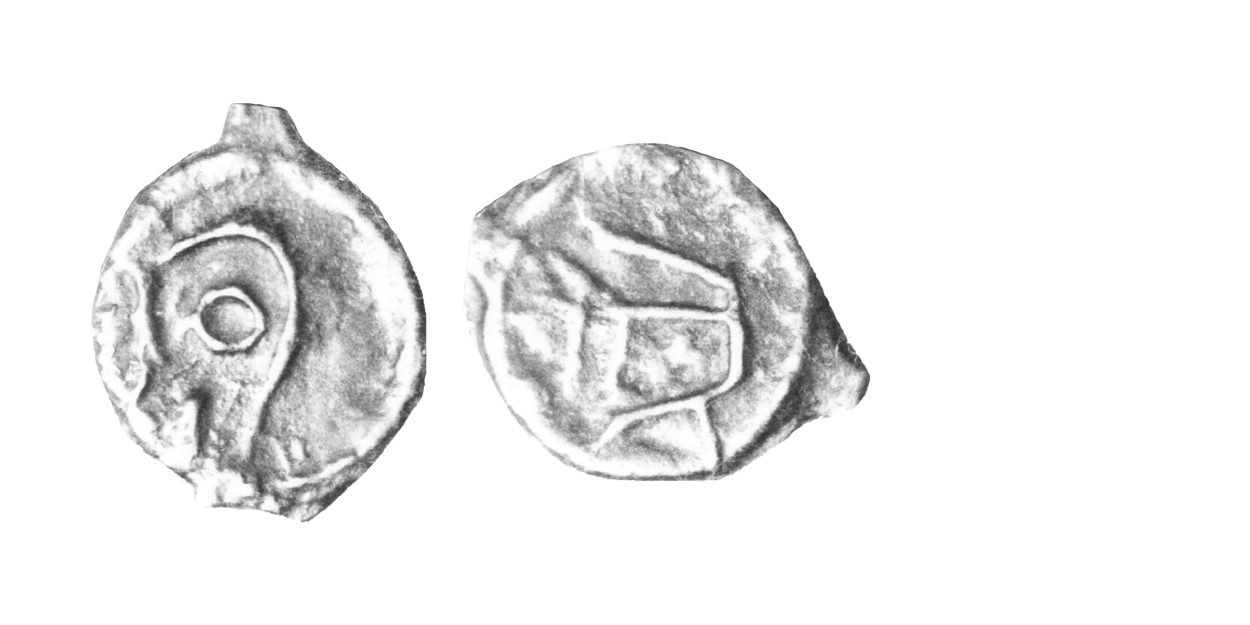
110 - 01 Sprue Experiment Type
ca. 100 B.C. Extremely Rare
Cast Bronze ca. 1.9 gms. 18 mm
Earliest Record: Van Arsdell, 1986b
OBV: Crude head of Apollo left
Identifying points:
1) head scribed in such a crude manner as to be barely recognizable
REV: Celticized bull
Identifying points:
1) bull scribed in such a crude manner as to be unrecognizable
CLASSIFICATION: Cantian B
NOTES:
- Sprue (casting tab) width only 3.5 mm
- Experimental type—attempt to use a smaller sprue to ease the separation of the coins from one another
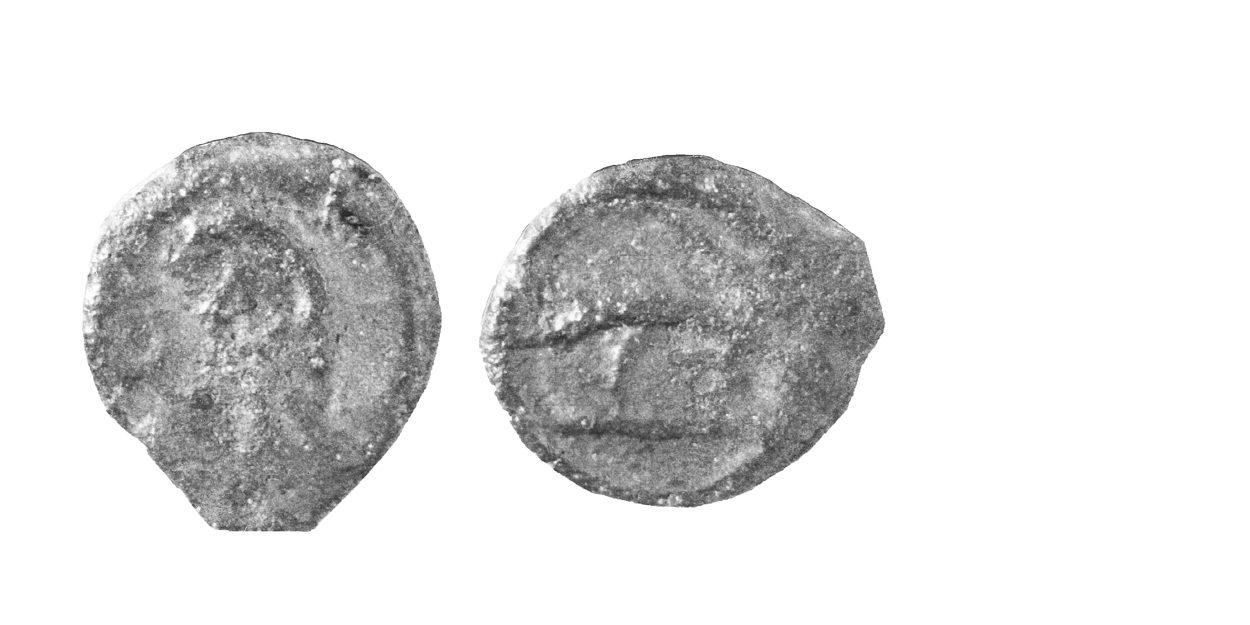
110 - 03 Sprue Experiment Type
ca. 100 B.C. Extremely Rare
Cast Bronze ca. 1.9 gms. 18 mm
Earliest Record: Allen, 1971
OBV: Crude head of Apollo left
Identifying points:
1) head scribed in such a sloppy manner as to be barely recognizable
2) normal sprue width
REV: Celticized bull
Identifying points:
1) bull scribed in a sloppy manner
2) normal sprue width
CLASSIFICATION: Cantian B
NOTES:
- Normal sprue (casting tab) width
- Experimental type – attempt to use a smaller sprue to ease the separation of the coins from one another
- This coin may represent the 'control' for the experiment, because it has the normal sprue width, but the same style as the thin sprue type.
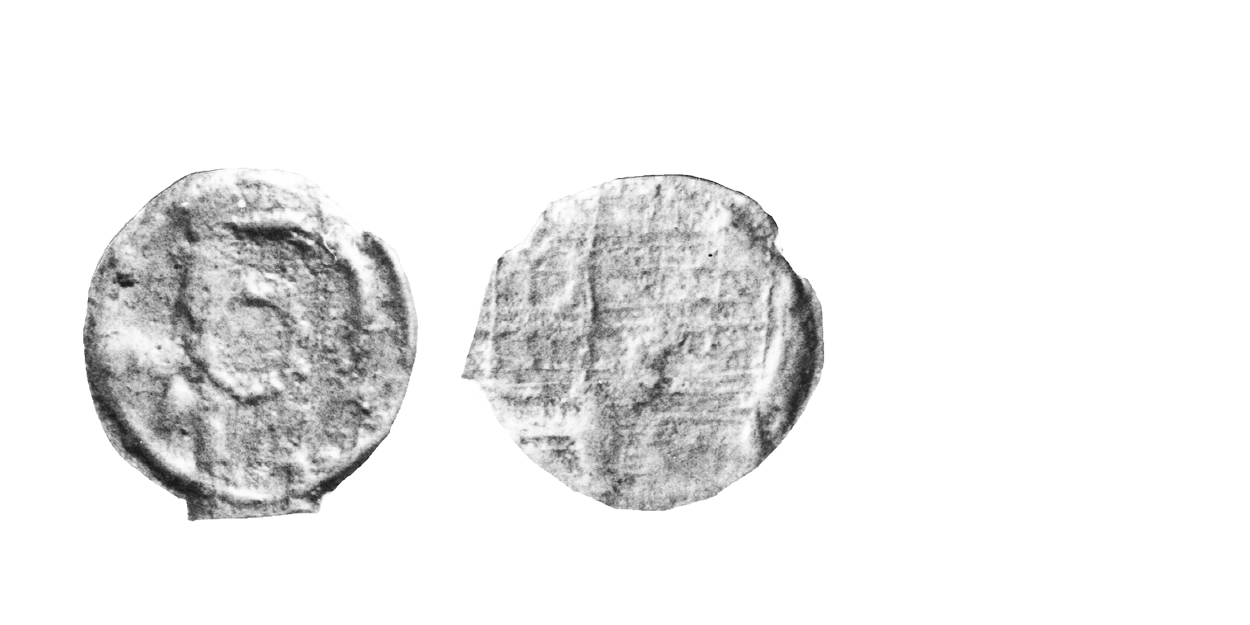
112 - 01 Crossed Striations Type
ca. 100 B.C. Extremely Rare
Cast Bronze ca. 1.7 gms. 18 mm
Earliest Record: Wild, 1966
OBV: Celticized head of Apollo left
Identifying points:
1) ring-and-pellet motif in centre of head
REV: Celticized bull charging left
Identifying points:
1) bull made up of curved lines
CLASSIFICATION: Cantian C
NOTES:
- Equally-thin striations cross at ninety degree angles in the coin's field
- The striations may appear on both sides, but are normally more pronounced on one side
- These striations were once thought to be the result of the use of papyrus, but this has been disproved – the pattern is not correct for papyrus
- The pattern was produced by textile, pressed into the clay to produce the cavity system
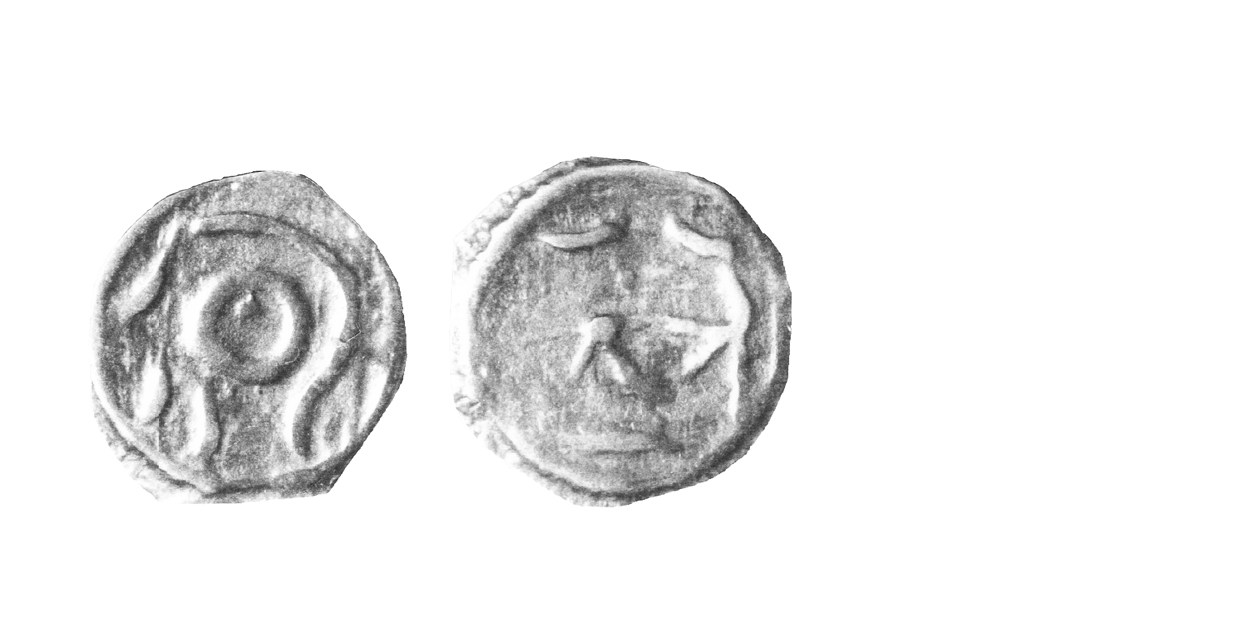
112 - 01 Crossed Striations Type
ca. 100 B.C. Extremely Rare
Cast Bronze ca. 1.7 1gms. 18 mm
Earliest Record: Wild, 1966
OBV: Celticized head of Apollo left
Identifying points:
1) ring-and-pellet motif in centre of head
REV: Celticized bull charging left
Identifying points:
1) bull made up of curved lines
CLASSIFICATION: Cantian C
NOTES:
- Equally-thin striations cross at ninety degree angles in the coin's field
- The striations may appear on both sides, but are normally more pronounced on one side
- These striations were once thought to be the result of the use of papyrus, but this has been disproved
- The pattern is not correct for papyrus
- The pattern was produced by textile, pressed into the clay to produce the cavity system
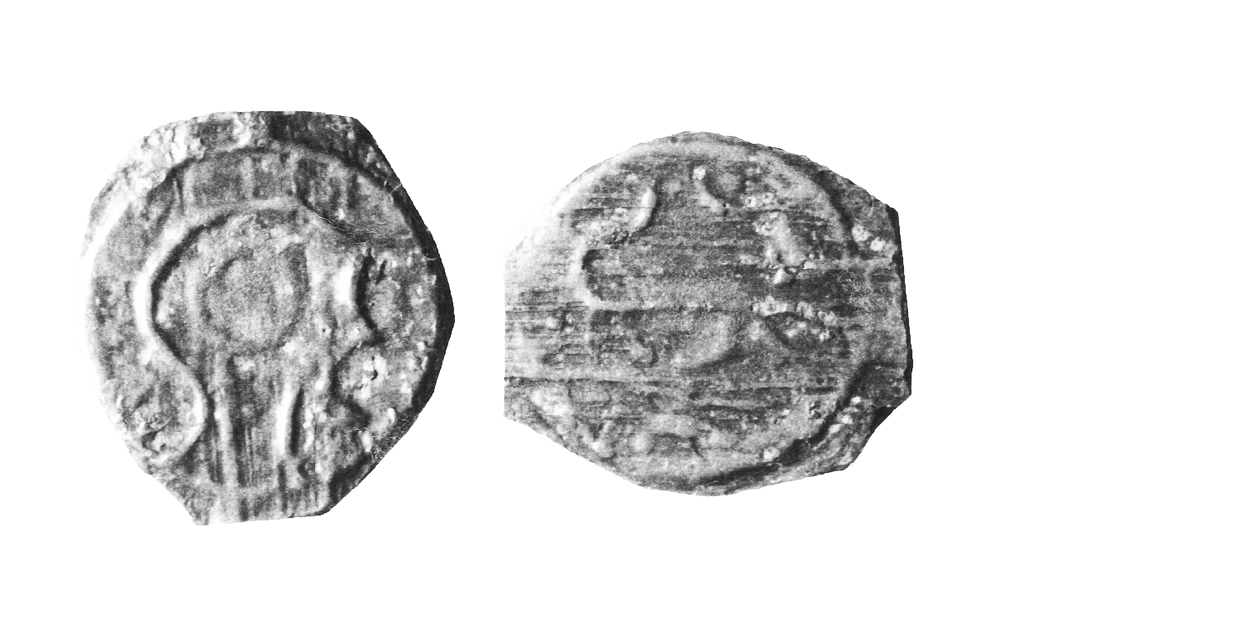
114 - 01 Medium Striations Type
ca. 100 B.C. Extremely Rare
Cast Bronze ca. 1.9 gms. 19 mm
Earliest Record: Van Arsdell, 1986b
OBV: Celticized head of Apollo right
Identifying points:
1) outline head, usually marred by striations
REV: Celticized bull charging right
Identifying points:
1) bull made up of curved lines
2) image often marred by striations
CLASSIFICATION: Cantian C
NOTES:
- Striations appear on both sides of the coin, and those on one side are parallel to those on the other side
- The striations are deep and fairly heavy, with blobs of metal interrupting them
- They are often so severe they ruin the image or create a flash problem
- The striations run into the flash, indicating they were produced independently of the cavity-formation process
- The moulds were produced by cutting a block of clay in two with a wire – the striations are the result of the cutting process
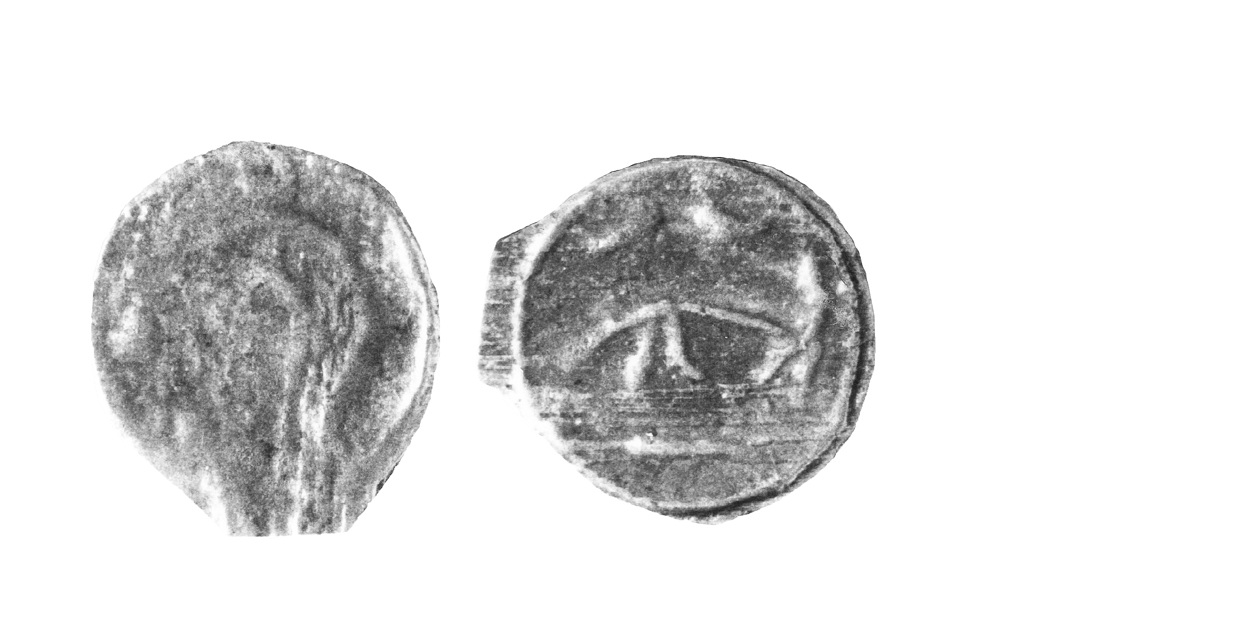
115 - 01 Medium Striations Type
ca. 100 B.C. Very Rare
Cast Bronze 19 mm
Earliest Record: Mack, 1953
OBV: Celticized head of Apollo right
dentifying points:
1) outline head, usually marred by striations
1) as 114 - 01, but head faces right
REV: Celticized bull charging left
Identifying points:
1) bull made up of curved lines
2) image often marred by striations
3) as 114 - 01, but bull faces left
CLASSIFICATION: Cantian C
NOTES:
- Celtic Coin Index records now indicate commoner than previously thought
- Striations appear on both sides of the coin, and those on one side are parallel to those on the other side
- The striations are deep and fairly heavy, with blobs of metal interrupting them
- They are often so severe they ruin the image or create a flash problem
- The striations run into the flash, indicating they were produced independently of the cavity-formation process
- The moulds were produced by cutting a block of clay in two with a wire – the striations are the result of the cutting process
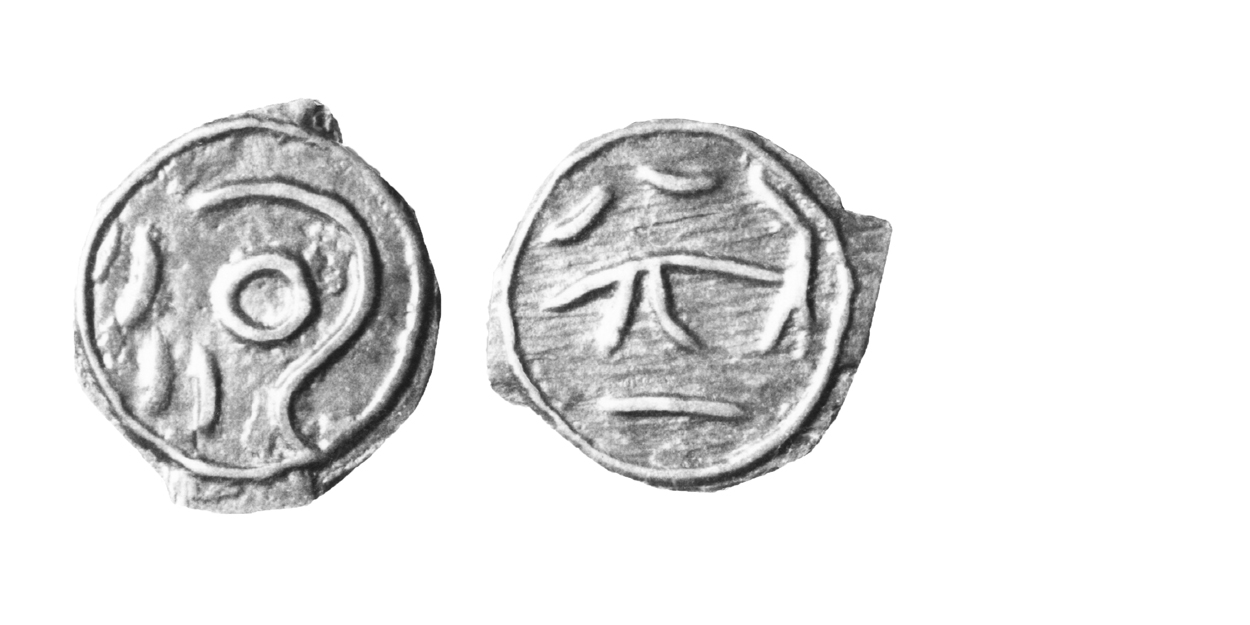
117 - 01 Heavy Striations Type
ca. 100 B.C. Rare
Cast Bronze ca. 2.1 gms. 19 mm
Earliest Record: Evans, 1855
OBV: Celticized head of Apollo left
Identifying points:
1) outline head of Apollo
REV: Celticized bull charging left
Identifying points:
1) bull made up of curved lines
CLASSIFICATION: Cantian C
NOTES:
- Celtic Coin Index records now indicate commoner than previously thought
- Striations normally appear on only one side of coin
- Striations are not so deep, but are broad and not necessarily parallel
- The striations were produced by wood pressed against the clay to smooth it
- This type vindicates Evans' 1864 assertion that wood was used in the mould making process
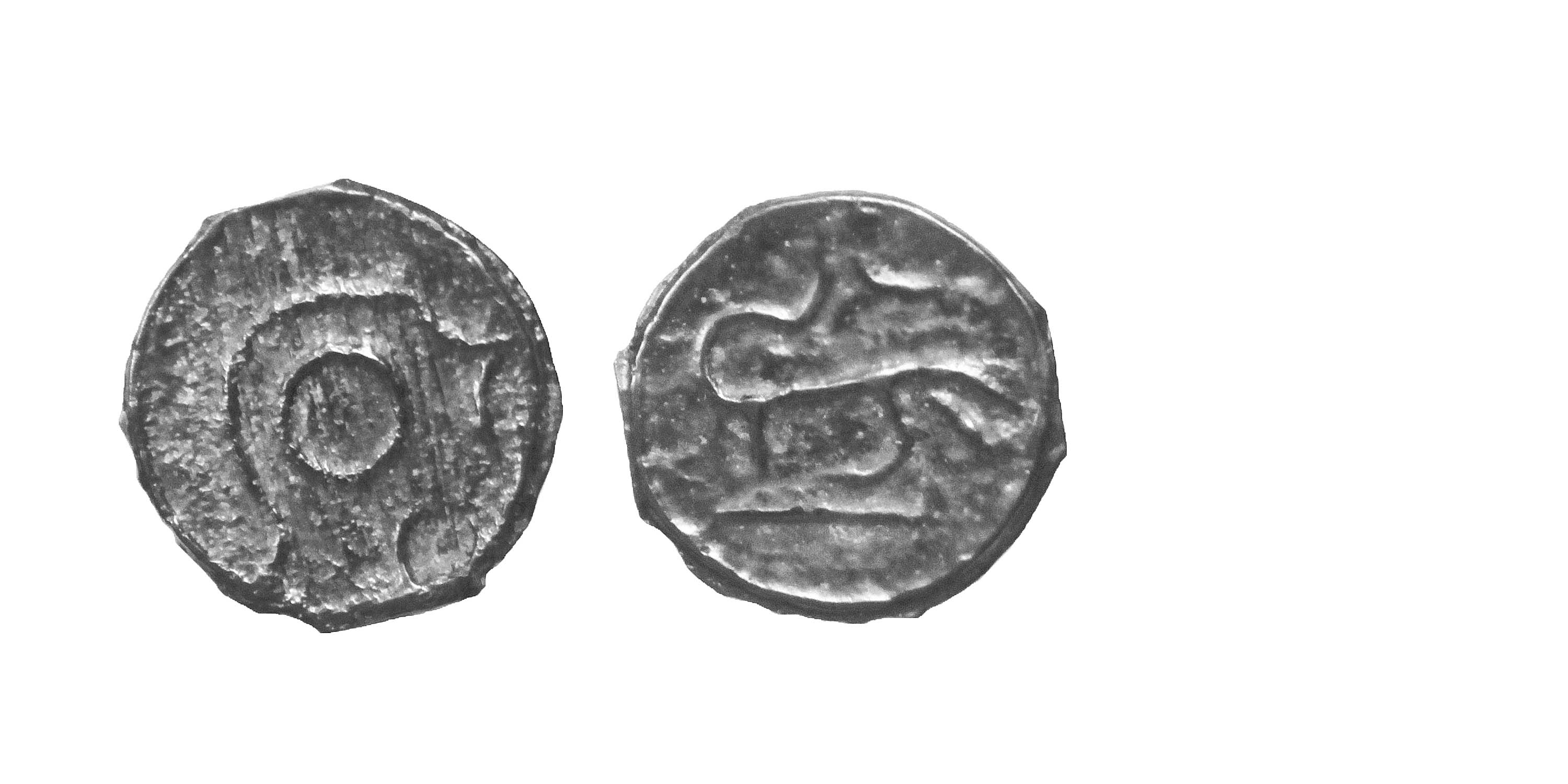
117 - 03 Heavy Striations Type
ca. 100 B.C. Extremely Rare
Cast Bronze ca. 2.1 gms. 19 mm
Earliest Record: Van Arsdell, 1993
OBV: Celticized head of Apollo right
Identifying points:
1) outline head of Apollo
REV: Celticized bull charging right
Identifying points:
1) bull made up of curved lines
CLASSIFICATION: Cantian C
NOTES:
- Striations normally appear on only one side of coin
- Striations are not so deep, but are broad and not necessarily parallel
- The striations were produced by wood pressed against the clay to smooth it
- This type vindicates Evans' 1864 assertion that wood was used in the mould making process
The Cantii and Other Kentish Tribes
Caesar named four Celtic rulers in Kent, implying several tribcs inhabited the area. The Kentish tribes, he declared, were amongst the most advanced in all Britain. His testimony is supported by the coin evidence the Kentish coinages are amongst the most sophisticated of all those in Britain.
Beginning about 125 B.C., the tribes along the Kentish coast received the first imports of continental coins. Within fifty years, a money economy existed to the extent that small-value coins were needed to facilitate trade. The first coins produced in Britain, starting about 100 B.C., were the Kentish CAST BRONZES. These reveal a remarkable knowledge of casting techniques and show how the Celts applied their innovative spirit to practical manufacturing problems.
Imports of gold staters and quarters allowed the Kentish tribes to forestall striking their own gold coins, and it was not until after the Gallic War they produced their first die-struck coins. When production began, however, a number of types were produced simultaneously, suggesting more than one tribe inhabited the region.
Around 30 B.C., Dubnovellaunus-in-Kent struck the first inscribed staters, these were later replaced by coins inscribed Vosenos. Sometime after 10 B.C. Vosenos disappears and Atrebatic/Regnan types appear with the name Eppillus. An Atrebatic/Regnan incursion appears likely, lured by the absence of a strong Trinovantian/Catuvellaunian leader to prevent it. Previously, small numbers of Trinovantian/Catuvelluanian coins appeared in Kent, suggesting Tasciovanus had been extending his economic influence over the area.
